HiWish計劃
HiWish是美國航空航天局創立的一項計劃,其宗旨是動員所有人為火星勘測軌道飛行器上的高解像度成像科學設備相機推薦一處拍攝地點[1][2][3]。該計劃於2010年1月啟動。在啟動後的頭幾個月內,曾有3000人註冊使用高解像度成像科學設備[4][5],首批圖像於2010年4月發佈[6]。公眾先後提出過12000多條建議,對火星上30個分區都提出了各自的目標。在第16屆國際火星協會年會上,這些推薦拍攝的圖像被用於三次演講。以下是截至2016年3月HiWish計劃發佈的4224張圖片中的一部分[7]。
冰川特徵[編輯]
有些景觀看上去類似地球上冰川流過的谷道,就像所有積冰消融後,谷底只剩下劃痕和冰磧—冰川攜帶的泥土和碎屑的空谷[8]。這些所謂的高山冰川被稱作類冰川形態(GLF)或類冰川流(GLF)[9]。類冰川形態是一條更晚的術語,可能更準確,因為無法確定這類結構當前是否還在移動[10]。
,
-
可能是冰川沿着山谷流下並在平原上攤開,矩形顯示了下一幅圖像中放大的部分。
-
上一幅圖像中矩形區域的放大,該區域在地球上被稱為高山冰川中的冰磧。
-
發育良好的同心坑沉積凹陷。
-
隕石坑底表上的冰川,冰川中的裂紋可能是一些深裂縫,隕坑壁上還分佈有沖溝系統。
-
舌狀流的全景圖
-
近距離觀察到的舌狀流
可能的冰核丘[編輯]
當作用力穿透脆性層時,通常可看到放射和同心狀裂紋,比如被石頭砸破的玻璃窗,這些特殊的裂縫可能是火星脆性表面下出現的某些東西所造成。水冰可能呈鏡面狀積聚在地表下,冰的密度比岩石小,當被推升到到表面後,就會呈現蜘蛛網般的圖紋,從而也就形成了這些有裂縫的土墩,這一過程與地球北極苔原上相似大小土墩的形成過程類似。這些特徵被稱為「冰核丘」(平戈斯),因紐特人詞彙[11]。冰核丘含有純水冰,因此,它們可能成為未來火星定居者的水源,許多看起來像地球上冰核丘的特徵都可在烏托邦平原(北緯35-50°、東經80-115°)[12]找到。
-
可能的冰核丘,照片帶比例尺。
-
可能冰核丘的近距觀察。
古老河流和溪流[編輯]
有大量證據表明水曾經在火星的河谷中流動過,來自軌道飛行器的圖片顯示了蜿蜒的河谷、叉谷,甚至還有逶迤彎曲的牛軛湖[13],下面的圖片顯示了其中的一些。
-
牛頓撞擊坑底部的河道
-
分叉河道
-
河道
-
分叉河道
-
河谷
-
阿拉伯區的河道
-
穿過隕石坑的河道系統
-
河道,溪流似乎已經侵蝕穿過了一座山丘
-
門農尼亞區一條顯示有河曲和截彎的河道
-
艾利達尼亞區的一條谷底河道
-
伊斯墨諾斯湖區河道近景圖
-
伊斯墨諾斯湖區帶有懸谷的河道
-
阿倫混沌的懸谷
-
伊斯墨諾斯湖內區內河道系統全景圖
流線體[編輯]
流線型形狀代表了火星上以前水流的更多證據,水流將地貌塑造成了流線體。
新撞擊坑[編輯]
-
高解像度成像科學設備圖像顯示了新發現的撞擊坑,白色箭頭所示的新隕石坑直徑約10碼,可能是一顆大西瓜般的物體碰撞造成,在早期拍攝的該地區照片中並未顯示有這一隕坑。
沙丘[編輯]
火星上許多地方都有沙丘,沙丘被季節性二氧化碳霜凍覆蓋,這種霜凍於初秋形成,一直持續到晚春。很多火星沙丘與陸地沙丘非常相似,但火星勘測軌道器高解像度成像科學設備獲得的圖像表明,火星北極地區的沙丘會受到季節性二氧化碳升華引發的顆粒流的改變,這是地球上從未見過的過程。許多沙丘呈黑色,因為它們來源於黑色火山岩玄武岩。地外沙海,例如在火星上發現的沙海,被稱為「undae」-來自拉丁語「波浪」。
-
高解像度成像科學設備在二座撞擊坑中發現的沙丘。
-
撞擊坑之間的沙丘,其中一些呈新月形。
-
艾利達尼亞區一座撞擊坑底部的沙丘,其中大部分為新月形沙丘,方框顯示了下一幅圖像的位置。
-
撞擊坑底部的沙丘,其中大部分是新月形沙丘。注意:這是放大的前一幅圖像中心區。
-
艾利達尼亞區的沙丘。
-
除霜沙丘和多邊形凹槽中的冰
-
除霜沙丘和多邊形凹槽中冰的彩照
-
解凍的表面,沙丘上的霜凍正在一片片地消失,但環多邊形地表的凹槽邊界仍然含有霜,因此它們是白色的。注意:沙丘北側邊沿尚未解凍,因為太陽光來自另一側。
-
莫羅撞擊坑內沙丘全景圖
-
第勒尼安海區的沙丘
-
第勒尼安海區沙丘近景圖
-
第勒尼安海區沙丘彩色近景圖,在沙丘表面可看到波紋。
-
圓頂沙丘的彩色近景圖
着陸點[編輯]
一些建議的目標成為2020年火星車任務的可能地點,目標地位於菲爾索夫和霍頓撞擊坑,這些地點是26處列選地點中的其中兩處,用以尋找生命跡象並收集樣本,並在以後帶回地球[14][15][16]。
-
菲爾索夫隕擊坑中的岩層,註:圖像中區域可在先前菲爾索夫撞擊坑岩層的圖像中找到,火星偵察軌道器背景相機拍攝。
-
菲索夫隕擊坑內各岩層特寫,這是前一幅圖像的放大版。
-
帶有顯示足球場大小方框的菲索夫隕擊隕擊坑岩層照片。
-
菲爾索夫隕擊坑內的岩層和斷層,箭頭顯示了一處大斷層,但圖中還有其他較小的斷層。
-
上一幅顯示岩層照片的近景圖。
景觀特徵[編輯]
暗坡條紋[編輯]
重現性坡線[編輯]
重現性坡線是溫暖季節延伸在斜坡上一些細小的暗色條紋,它們可能是液態水的證據[18][19][20]。然而,有關是否是水或需要多少水仍存有爭議[21] [22] [23]。
-
水手谷部分地區廣角視圖,方框顯示的重現性坡線位置將在下一幅圖像中被放大。
-
重現性坡線彩色近景圖,箭頭指示了一些重現性坡線。
岩層[編輯]
火星上的許多地方都有重疊的岩層,岩石可以以多種方式形成岩層,火山、風或水可以形成地層[24],地下水的作用可以使地層變硬。
,
-
丹尼爾森隕擊坑底部的層狀墩。
-
丹尼爾森隕擊坑地面上岩層和黑色塵埃彩色近景圖。
-
丹尼爾森隕擊坑地面上的岩層和黑色塵埃彩色近景圖,可在圖像中看到巨岩。
-
尼爾森隕擊坑地面上的岩層和黑色塵埃彩色近景圖,箭頭指示了斷層處。
-
丹尼爾森隕擊坑地面岩層近景圖,在圖像中可看到一些斷層。
-
放大的白色岩丘,方框顯示了足球場大小的區域。
-
朝向白色岩丘頂部的近景圖,方框顯示了足球場大小的區域。
-
白色岩丘的頂部,方框顯示了足球場大小的區域。
-
埃俄利斯區中的層狀地形。
-
層狀丘近景景,注意:這是上一幅圖像的放大版。
-
層狀丘近景景,注意:這是先前圖像的放大版
-
阿拉伯區裏的層狀地形,
-
丹尼爾森撞擊坑部分區域的廣角視圖。
-
前一幅丹尼爾森撞擊坑圖像的放大版,方框顯示足球場大小的區域。
-
丹尼爾森撞擊坑地層特寫-可以看到巨石和黑色沙粒。
-
伊烏斯峽谷南部槽溝中的地層特寫圖。
-
洛托隕擊坑(Lotto)中的岩層特寫
-
滕比高地區的地層
-
滕比高地區的地層,註:這是前一幅圖像的放大版。
-
各地層近景圖,至少有一層為可能代表水合礦物的淺色層。
-
各地層近景圖
這組岩層都來自阿拉伯區的一座撞擊坑中。
-
撞擊坑各地層的廣角視圖,該圖像的部分區域將在後面的其他圖像中放大。
-
地層近景圖,方框顯示了足球場大小的區域。
-
地層近景圖,方框顯示了足球場大小的區域。
-
地層近景圖,方框顯示了足球場大小的區域。
-
地層近景圖
-
地層近景圖
-
地層近景圖
-
地層近景圖
-
地層近景圖
-
盧羅斯谷中的地層近景圖
-
盧羅斯谷中的地層近景圖,註:這是前一幅圖像的放大版。
-
盧羅斯谷中的地層近景圖,註:這是前一幅圖像的放大版。
-
盧羅斯谷中的地層近景圖,註:這是前一幅圖像的放大版。
-
盧羅斯谷中的地層近景圖,註:這是前一幅圖像的放大版。
冰蓋中的層狀結構[編輯]
-
北部冰蓋中角度不一致的地層。
-
北部冰蓋地層近景圖,箭頭指示了不一致的角度。
-
北部冰蓋地層彩色近景圖
-
北部冰蓋中暴露的地層
-
北部冰蓋中暴露的地層
沖溝[編輯]
火星沖溝是在火星上發現的一系列狹窄沖刷溝壑以及相關的下坡沉積物,因與地球上的沖溝相似而得名,最早是在火星全球探勘者號拍攝的圖像中所發現,它們常出現在陡坡上,特別是隕石坑的坑壁上。通常,每條沖溝溝頭都有一處水系蓄水窪地,坡下則形成一片沖積扇,還有連接兩條沖溝的細叉溝,使整個沖溝呈沙漏狀[25]。人們認為這些沖溝相對年輕,因為上面幾乎沒有覆蓋隕石坑。
根據它們的類型、外觀、位置和地點以及與被認為是富含水冰地貌的明顯相互作用,許多研究人員認為,鑿刻沖溝的過程涉及液態水。然而,這仍然是一個有待進一步研究的課題。
,
-
沖積扇特寫,顯示上面沒有隕石坑;因此很年輕。位置為法厄同區。
-
阿西達里亞海區一座撞擊坑內側坡壁上的沖溝。
-
沖溝渠壑特寫。該圖像顯示了眾多流線型特徵和一些沿溝渠延伸的階坎,表明它們是由水流形成的。當水位少量下降並保持一段時間後,通常會形成階坎。圖像拍攝位置為阿西達里亞海區,注意:這是前一幅圖像的放大版。
-
法厄同區撞擊坑內的沖溝。
-
沖積扇近景圖,註:此為前一幅圖像的放大。
-
溝頭窪地近景圖,註:此為前一幅圖像的放大。
-
隕石坑中的沖溝
-
上一幅圖像中的沖溝近景圖。沖溝非常彎曲,由於溝渠常形成彎曲狀,被認為它們形成於水流。如今,人們認為它們可能是由乾冰造成的。
緯度相關覆蓋層[編輯]
火星大部分表面都有一層富含水冰的厚厚覆蓋層,它們是由過去多次從天空飄落的冰芯塵埃所構成[26][27][28],在覆蓋層中的部分區域可看到一系列的分層結構[29]。
-
艾利達尼亞區的覆蓋層。
-
覆蓋層近景圖,覆蓋層可能由過去氣候條件下從天空飄落的冰和塵埃組成,位置為刻布壬尼亞區。
-
伊斯墨諾斯湖區覆蓋層近景圖,沿隕坑邊沿顯示的箭頭,突出指示了覆蓋層的厚度。
-
顯示伊斯墨諾斯湖區覆蓋層厚度的近景圖。
-
阿耳卡狄亞區表面有斑點的覆蓋層廣角視圖.
-
覆蓋層近景圖
-
覆蓋層近景圖
當雪和塵埃包裹的冰降落後,有充分的證據表明該覆蓋層富含水冰。在許多表面常見的多邊形表明土壤富含水冰;2001火星奧德賽號發現了高水平的氫(可能來自水)[30][31][32][33][34];軌道上測得的熱量表明是冰[35][36];鳳凰號(航天器)降落在一處多邊形區,發現了水冰並進行了直接觀測[37][38],事實上,它的着陸火箭曾暴露出了純冰。理論預測在幾厘米厚的土壤下就會發現水冰,該覆蓋層被稱為「緯度相關覆蓋層」,因為它的存在與所處緯度有關。正是這層覆蓋層的破裂,後來才形成了多邊形地面,這種富冰地面的開裂是根據物理過程所預測的[39][40]
[41][42][43][44][45]。
多邊形圖案地面[編輯]
多邊形、有圖案的地面,在火星一些地區非常常見[46][47][48][49][44][50][51],並被普遍認為這是由地面上冰的升華所導致。升華是固體冰直接變成氣體,與地球上乾冰的情況類似。火星上呈現多邊形地面的地方可能表明未來定居者可在那裏找到水冰。圖案地面覆蓋層是由在氣候不同時從天空落下的冰核塵埃所構成,它們又被稱為「緯度相關覆蓋層」 [26][27][52][53]。
,
-
帶霜凍的隕石坑多邊形地面廣角圖。
-
較低處帶霜凍的多邊形地面近景圖。
-
更接近的多邊形地面圖
-
較低處帶霜凍的多邊形地面近景圖,也可看到圓形的圖案
-
箭頭顯示中央凸起多邊形地面,位於卡西烏斯區,高解像度成像科學設備放大的圖像。
-
標註有中央凸起多邊形及中央凹陷多邊形地面的貼心形地貌,位於卡西烏斯區,高解像度成像科學設備放大的圖像。
-
卡西烏斯區中央凸起和凹陷多邊形地面,高解像度成像科學設備放大的圖像。
-
中央凸起多邊形地面特寫,多邊形之間的凹槽清晰可見。位置為伊斯墨諾斯湖區。
-
卡西烏斯區中央凹陷多邊形地面,高解像度成像科學設備放大的圖像。
-
冰川口近景圖,可看到中央凸起多邊形,方框顯示了足球場大小的區域。
-
冰川附近的中央凸起多邊形地面近景圖,方框顯示了足球場大小的區域。
-
冰川附近的中央凸起多邊形地面近景圖。
-
一組通道廣角圖,放大後表面某些部分顯出圖案地面。
-
圖案地面,前一幅圖像的特寫。
-
山脊,前一幅圖像的特寫。
-
前一幅圖像的彩色視圖。
-
圖案在面彩色視圖,前一幅的放大版。
複雜多邊形圖案地面[編輯]
-
挪亞區多邊形地面廣角圖,該圖像的部分區域將在後面的圖中放大。
-
多邊形地面
-
多邊形地面近景圖,箭頭指示了小隕坑內的巨石。
-
多邊形地面近景圖
-
多邊形地面近景圖
裸露的冰蓋[編輯]
HiWish計劃下高解像度成像科學設備在拍攝的米蘭科維奇撞擊坑照片中發現了許多三角窪地,研究人員發現,在這些地方僅1-2米深的土壤下貯藏了大量的水冰。根據發表在《科學》雜誌上的這項研究,這些窪地在面向北極的峭壁中含有水冰。火星上共發現八處有水冰的地方,其中米蘭科維奇撞擊坑是北半球唯一的一處,該項研究是通過火星勘測軌道飛行器上的儀器進行的[54][55][56][57][58]。
以下圖像是這次地下冰蓋研究中所涉及的一處[59]。
-
從米蘭科維奇撞擊坑部分區域廣角視圖,這裏很多的窪地坡壁上都有冰。
-
前一幅圖像的近景圖,被注意到的一些三角形窪地,方框中的區域中下圖中被放大
-
窪地近景, 箭頭指向的地方有一層非常薄的1-2米覆蓋物,據認為是冰。
這些三角窪地類似於貝狀地形中的窪地,但貝狀地形一般顯示為面向赤道的緩坡,並且呈圓形,而這裏討論的窪地陡坡卻為面朝北極的峭壁,並且發現於南北緯55-59度之間[59],貝狀地形在火星中緯度地區很常見,分別位於南北緯45°到60°之間。
扇形地形[編輯]
扇形地形在火星南北45°到60°之間的中緯度地區很常見,在北半球的烏托邦平原區[60][61]和南半球的佩紐斯和安菲特里忒火山口區尤為突出[62][63]。這種地形由帶扇貝或荷葉邊狀口沿、無凸起壁壘環的淺窪地構成,通常稱為「扇形窪地」或簡稱「扇形地形」。扇形窪地可能呈單獨或聚集出現,有時似乎串聯在一起。一處典型的扇形窪地顯示為面向赤道的緩坡和面朝極地的峭壁,這種不對稱地形可能是由於日照差異造成的。扇形窪地據認為是地下物質(可能是間隙冰)因升華消失而形成,這一過程目前可能仍在發生[64]。
2016年11月22日,美國宇航局報告稱,在火星烏托邦平原地區發現了大量地下冰[65],據估計,檢測到的水量相當於一座蘇必利爾湖水量[66][67]。該地區的水冰容量是根據火星勘測軌道飛行器上的探地雷達儀,簡稱「沙拉德」(SHARAD)的測量結果確定的。根據從探地雷達獲得的數據,測定的「電容率」或介電常數,介電常數值與大量聚集的水冰相一致[68][69][70]。2016年11月22日,美國宇航局報告稱,在火星烏托邦平原地區發現了大量地下冰[65],檢測到的水量相當於一座蘇必利爾湖[66][67]。該地區的水冰容量是根據火星勘測軌道飛行器上的探地雷達儀,簡稱「沙拉德」(SHARAD)的測量結果確定的。根據從探地雷達獲得的數據,測定的「電容率」或介電常數,介電常數值與大量聚集的水冰相一致[68][69][70]。
,
-
扇形地面
-
扇形地面特寫,表面被劃分成很多多邊形,這類地貌在地表被凍結和融化的地區很常見。注意:這是先前圖像的放大版。
-
扇形地面
-
扇形地面表面被劃分成很多多邊形,這類地貌在地表被凍結和融化的地區很常見。注意:這是先前圖像的放大版。
-
中央凹陷多邊形地面, 帶有顯示箭頭,圖像被高解像度成像科學設備放大。
-
卡西烏斯區的扇形地形。
-
卡西烏斯區的扇形地形。
底座形撞擊坑[編輯]
底座形撞擊坑是一種噴出物在隕坑周圍形成一座凸起平台(如基座)的撞擊坑。當撞擊坑噴出的物質形成一層耐侵蝕層後,它周圍的區域受侵蝕速度會較其他區域更慢,由此就會形成一座基座。一些基座被精確測出高於周邊區域數百米,意味着有數百米的材料被侵蝕掉了,結果使得隕石坑及其噴出物覆蓋層都高聳於周邊環境之上。底座形隕石坑是在水手號任務期間首次觀測到的[71][72][73][74]。
,
環形模具隕石坑[編輯]
環模隕石坑被認為是由小行星撞擊下面分佈有冰層的地面所形成,撞擊使冰層反彈,形成「環形模具」形狀。
-
伊斯墨諾斯湖區]]各種大小坑底的環形模具隕石坑。
-
環形模具隕坑區廣角視圖
-
環形模具隕石坑近景,註:這是前一幅圖像的放大版。
-
大撞擊坑坑底上的環形模具隕石坑全景圖
-
環形模具隕石坑
-
環形模具隕石坑和腦紋地形近景
暈坑[編輯]
-
沿邊緣密佈着大量巨石的底座式撞擊坑被稱為「暈坑」[75]。
-
撞擊坑左下側邊緣上的巨石近景圖,方框區尺寸有足球場大,所以,巨石的大小大致相當於一輛汽車或一幢小屋。
-
位於撞擊坑邊緣的巨石近景,巨石的大小大致相當於一輛汽車或一幢小屋。
塵暴痕跡[編輯]
塵暴痕跡可能非常美,起因可能是巨大塵暴吹去了火星表面鮮艷的塵埃,從而暴露出一些暗黑層所形成。火星上的塵暴已被從地面和軌道高空拍攝到,它們甚至還吹走了火星上兩輛火星車太陽能電池板上的灰塵,從而大大延長了它們的使用壽命[76]。研究表明,塵暴痕跡模式每隔數月就會發生變化[77],一項結合了高解像度立體相機(HRSC)和火星軌道器相機(MOC)數據的研究發現,火星上一些大型塵暴的直徑為700米(2300英尺),持續時間至少有26分鐘[78]。
-
塵暴痕跡
-
塵暴痕跡
-
頂部顯示有塵暴痕跡的丹尼爾森撞擊坑地層照片,位置為歐克西亞沼區。
雅丹地貌[編輯]
雅丹地貌在火星上一些地區很常見,特別是在所謂的「梅杜莎槽溝層」中,這種地層被發現於亞馬遜區和赤道附近[79]。它們是由風颳起的沙粒大小的顆粒作用形成,因此,雅丹地貌通常指示出形成時的風向[80]。由於雅丹地貌中很少出現撞擊坑,因此被認為相對年輕[81]。
,
羽流和蜘蛛狀結構[編輯]
火星上某些時候,會發生黑色氣體和塵埃噴發,風經常把它們吹成扇形或尾巴狀。在冬季,大量積聚的霜凍,被直接凍結在由覆蓋着數層塵埃和沙粒的水冰所構成的永久性極地冰蓋表面。沉積物啟始於一層佈滿塵埃的二氧化碳霜凍,在整個冬季,它們會重新結晶並變得更為緻密。霜凍中的塵埃和沙粒慢慢下沉。到春季氣溫上升時,霜凍層已變成了一層約3英尺厚的半透明冰,覆蓋在深色沙塵基底上。這層黑色的沙塵會吸收陽光,使水冰升華(直接氣化),最後,大量氣體積聚,壓力逐慚升高。當發現一處薄弱點時,氣體就會逸出並吹出塵埃,流速可達每小時100英里[82]。計算表明,噴出的羽流高達20-80米[83][84]有時也可在地表看到被稱為「蜘蛛」的黑色通道[85][86][87],當這一過程發生時,表面似乎佈滿了黑點[82][88]。
現已提出許多想法來解釋這些特徵[89][90][91][92][93][94],這些特徵可在下面的一些圖片中看到。
-
羽流廣角視圖,當放大後許多羽流顯示為蜘蛛狀結構。
-
羽流,箭頭指示了一道雙羽流,可能是風向變化所致。
-
長羽流
-
蜘蛛狀結構
-
羽流和蜘蛛狀結構
-
羽流和蜘蛛狀結構
-
羽流和蜘蛛狀結構
-
羽流和蜘蛛狀結構全景圖
-
羽流和蜘蛛狀結構
上部平原單元[編輯]
在火星中緯度地區發現了一種被稱為「上部平原單元」的50-100米厚覆蓋層殘餘物,在研究都特羅尼勒斯桌山群(伊斯墨諾斯湖區)區時被首次發現,但其他地方也有出現。該類殘餘物由隕石坑中和沿桌山的一組傾斜層構成[95]。傾斜層的大小和形狀可能各不相同,有些看起來像中美洲阿茲特克金字塔。
-
隕石坑中的層狀結構,可能曾是覆蓋面積更大的層狀單元殘餘物,這種單元由天空落下的冰核塵埃所構成,圖片位置為希臘區。
-
位於希臘區的傾斜層結構。
-
位於希臘區的傾斜層結構。
-
位於希臘區的傾斜層結構。
-
層狀結構
-
伊斯墨諾斯湖區分佈於桌山坡壁上的下傾層近景圖。
-
伊斯墨諾斯湖區的下傾層近景圖。
-
伊斯墨諾斯湖區下傾層廣角圖,在圖像底部也可看到沖溝。
這種單元也會退化為腦紋地形,腦紋地形是一種3-5米高的迷宮狀壟脊區。有些壟脊可能由冰核構成,因此它們可能是未來定居者的水源.
-
伊斯墨諾斯湖區的腦紋地形。
-
層狀特徵和腦紋地形,上部平原單元經常會轉變為腦紋地形。
-
腦紋地形正在從上部平原單元的解體中形成,箭頭指向了即將轉變為腦紋地形的破裂位置。
-
腦紋地形正在從上部平原單元的解體中形成,箭頭指向了即將轉變為腦紋地形的破裂位置。
-
正在形成中的腦紋地形
-
正在形成中的腦紋地形,註:這是前一幅圖像的放大版,箭頭所指之處為腦紋地形開始形成的地方。
-
正在形成中的腦紋地形,註:這是前一幅圖像的放大版,箭頭所指之處為腦紋地形開始形成的地方。
-
正在形成中的腦紋地形,註:這是前一幅圖像的放大版。
-
正在形成中的腦紋地形,註:這是前一幅圖像的放大版。
-
帶標註的開放閉合型腦紋地形,地點為伊斯墨諾斯湖區
-
伊斯墨諾斯湖區正在形成中的腦紋地形。
-
正在形成中的腦紋地形近景圖
-
正在形成中的腦紋地形,註:這是前一幅圖像的放大版。
-
正在形成中的腦紋地形,註:這是前一幅圖像的放大版。
上部平原單元的一些區域顯示出大型裂縫和帶凸起邊緣的凹槽,這些地區被稱為棱狀上部平原(Ribbed Upper Plains)。據信斷裂起始於應力引起的小裂縫,因為當碎屑堆聚集在一起或碎屑堆靠近邊緣時,此類地點就會產生擠壓應力,這在棱狀上層平原很常見,應力則會引發斷裂過程。裂縫暴露了更多的地表,因此地層中更多的冰升華到行星稀薄的大氣層中。最終,小裂縫變成為大峽谷或大槽溝。
-
發育良好的棱狀上部平原地層,它們起始於一些表面小裂縫,並隨着冰從裂縫中升華而進一步擴展開。
-
下傾層,在圖片右上方可看到棱狀上部平原地層,它們形成於上部平原單元,反過來又會被侵蝕成腦紋地形。
-
顯示棱狀地形和腦紋地形的廣角圖
-
棱狀地形形成於上部平原單元,起始於因冰升華而擴展開的地表裂縫,方框表示足球場大小的區域。
小裂縫通常包含小洞坑和洞坑鏈,這些被認為是由地表上的冰升華所形成[96][97]。火星表面大部分區域都蘊含了水冰,冰被一層1米厚的塵埃和其他物質所保護。然而,一旦出現地表縫,將會使水冰暴露在稀薄的大氣層中,在很短時間內,冰將消失在寒冷稀薄的大氣中[98][99],這一過程稱為升華,乾冰在地球上也有類似的行為。當鳳凰號火星探測器發現裸露的冰塊在幾天內消失時,在火星上觀察到了升華現象 [37][100]。此外,高解像度成像科學設備還發現了底部有冰的新隕石坑。隔了一段時間,它曾看到的積冰就已消失無蹤了[101]。
據認為,上層平原單元來自於天空中降落的物質,它覆蓋在各種表面上,好像它均勻落下。與其他堆積覆蓋層一樣,上層平原單元具有層狀、細粒度和富含冰,它分佈普遍,似乎沒有來源點。火星某些區域的表面外觀是由於該單元的退化形成的,它也是造成舌狀岩屑坡表面外觀的主要原因[97]。據信,上部平原覆蓋層單元和其他覆蓋層單元的分層,是由該行星氣候發生的重大變化所致。模型預測,隨着地質時間推移,火星自轉軸傾角或傾斜度可能會從目前的25度改變到超過80度。高傾斜期間將導致火星極地冰蓋中的冰重新分佈,並改變大氣層中的灰塵含量[102][103][104]。
線性脊狀網[編輯]
在火星隕石坑內及周圍不同地方都可以發現線性脊狀網[105],這些脊線通常以格子形相交的直線形式出現,有數百米長,幾十米高和數米寬。據認為,隕石撞擊在地表形成了裂縫,這些裂縫後來充當了流體通道,流體使結構物膠結 。隨着時間的推移,周圍地層被侵蝕掉,留下這些堅硬的壟脊。
由於壟脊出現在有粘土的地方,這些地層可作為粘土的標誌,而粘土的形成需要水,這裏的水可以維持生命[106][107][108]。
-
山脊網,山脊可以通過各種方式形成。
-
山脊彩色近景圖,與一幅為同一圖像。
-
線性脊線網彩色特寫圖
-
來自前一幅同一地區的更多線性脊線網。
-
亞馬遜區線性脊線網。
-
第勒尼安海區線性脊線網。
-
卡西烏斯區線性脊線網。
-
阿耳卡狄亞區線性脊線網全景圖。
-
阿耳卡狄亞區山脊網近景圖,箭頭指向小而直的山脊。
-
脊線網全景圖,後面的圖像中放大了該圖的部分區域。
-
脊線網近景圖,前一幅圖像的放大版。
-
脊線網近景圖,前一幅圖像的放大版,方框區面積相當於足球場大。
-
脊線網近景圖,此為前一幅圖像的放大版。
-
脊線網近景圖,此為前一幅圖像的放大版。 圖像中有一座顯示出分層結構的小桌山。
-
脊線網彩色近景圖,此為前一幅圖像的放大版。
-
大型山脊線網全景圖
-
脊線網近視圖,方框區面積相當於足球場大。
-
脊線網彩色近景圖。
破碎地面[編輯]
火星部分地區已破裂成桌山和山谷地形,其中一些可能相當壯觀。
-
斷裂地面廣角圖
-
斷裂地面近景圖
-
破裂地面近景圖,方框中區域相當於足球場大小,所以,這些巨石有房屋般大。
-
破裂地面彩色近景圖。
桌山[編輯]
-
桌山,在遙遠未來的某一天,可能會在一座桌山周圍舉行一場精彩的比賽。
-
阿西達里亞海區桌山岩層
-
桌山岩層近景
-
帶有暗坡條紋的層狀桌山和土墩
-
帶暗坡條紋的層狀小桌山近景圖,方框中區域相當於足球場大小。
-
非常近距的單幅視圖,從一座岩丘岩層中剝離出的巨石群。
地面塌陷形成的桌山[編輯]
-
桌山群,圓角方框中包含的可能是一些已剝離開的桌山。
-
放大的桌山群視圖,其中一座的表面已形成四方形。
-
桌山斷裂形成直邊。
冰下火山[編輯]
有證據表明,火山有時會在冰下噴發,就像地球上的一樣。當火山噴發時,大量積冰融化為水逸出,隨後使表面發生開裂並崩塌,呈現同心裂縫和好似被撐開的大塊地面[109]。像這類地點最近可能曾存在過液態水,因此是很可能會尋找到生命證據的地方[110][111]。
-
地面塌陷時形成的傾斜層
-
地面塌陷時形成的傾斜層
-
桌山斷裂破碎成巨石塊
斷裂塊體[編輯]
在一些地方,大型裂縫會使表層破裂,有時裂縫會形成直邊和大立方體巨岩。
-
正在形成裂縫的桌山全景圖。
-
前一幅圖像的放大片,矩形表示足球場般大小。
-
正在形成中的巨石塊特寫。
-
正在剝落的巨石塊特寫,矩形表示足球場般大小,所以巨石尺寸如有建築物大。
-
正在剝落中的巨石塊特寫,表面可看到很多長裂縫。
-
破裂地表,靠近圖像頂部的地表正被侵蝕成腦紋地形。
-
顯示破裂為巨石塊的淺色特徵全景圖。
-
顯示正在剝落中的巨石塊近景圖,注意:這是前一幅圖像的放大版,方框中區域代表足球場般大小。
熔岩流[編輯]
-
塔爾西斯區的熔岩流
-
帶標註的熔岩流特寫,這是前一幅熔岩流圖像的放大。
-
標註出了古老和較年輕的熔岩流。
-
流線體狀熔岩和熔岩筏全景圖
-
前一幅圖像中的熔岩筏近景圖。
無根火山錐[編輯]
所謂的「無根火山錐」產生於下方有地面冰的熔岩流爆炸[112][113]。冰被熔岩流融化變成蒸汽,在爆炸中膨脹,形成圓錐體或圓環。在冰島也發現了熔岩覆蓋在被水浸透的基底上而產生的類似特徵[114][112][115]。
-
埃律西昂區無根火山錐場全景圖。
-
無根火山錐近景,其尾跡表明熔岩流正通過富含冰的地面上向西南移動。
-
近距看到的足球場大小的火山錐。
-
近距看到的埃律西昂區無根火山錐,這些火山錐可能是熾熱熔岩流過富冰地面時所形成的。
-
無根火山錐,這些圓環或圓錐體群被認為是熔岩流過水冰或含有水冰的地面所引起。冰被瞬間氣化,吹出一座圓環或圓錐體。在這裏,熔岩鏈中的彎曲可能是熔岩改變方向造成的。有些沒有產生環形或錐體,可能是因為熔岩移動得太快了,因此無法讓它們形成一座完整的圓錐體。該地點為埃律西昂區。
泥火山[編輯]
有些看起來像火山的特徵中,有一些可能是泥火山,受壓的泥漿被迫向上拱起形成錐體。這些特徵可能是尋找生命的地方,因為它們將可能的生命帶到地表,並保護了它們免遭輻射的破壞。
-
可能為泥火山的大型火山錐場,位置為阿西達里亞海區。
-
可能的泥火山特寫,注意:這是前一幅圖像的放大版。
-
阿西達里亞海區的泥火山,在該區域有很多的泥火山。
-
阿西達里亞海區可能的泥火山。
-
泥火山群全景圖
-
泥火山群近景
-
泥火山和巨石近景圖
希臘平原地表特徵[編輯]
在希臘平原的部分地面上發現了一些奇怪的地形,科學家們尚無法確定它們是如何形成的。
-
希臘平原地表上的扭曲帶
-
希臘平原地表特徵
-
希臘平原地表特徵
-
希臘地表上的山脊群近景
被掘出的隕坑[編輯]
被掘出隕坑似乎是被重新揭露出來的[116],據信,它們形成後被掩埋,而現在正隨着地層的侵蝕,被重新挖掘出來。隕石坑形成時,會摧毀它下面的結構。在下面的示例中,只能看到隕坑的一部分。如果隕石坑形成於分層特徵後,它將會撞毀掉下方的部分特徵,我們將能看到整個隕石坑。
-
被掘出隕石坑全景圖
-
被掘出隕石坑近景圖,該隕石坑現在和過去都位於一系列傾斜層之下。
如何建議要拍攝的圖像[編輯]
要推薦高解像度成像科學設備拍攝圖像的位置,請訪問以下站點:http://www.uahirise.org/hiwish (頁面存檔備份,存於互聯網檔案館)
在註冊時,需要您提供身份識別號(ID)和密碼。當你選擇要成像的目標時,必須先在地圖上選擇一處準確的位置,並寫下為何要拍攝該圖像。如果你的建議被接受,可能需要3個月或更長時間才能看到你要的照片。您將會收到一封有關您建議圖像的電子郵件。電子郵件通常在每月的第一個星期三下午稍晚時到達。
另請參閱[編輯]
參考文獻[編輯]
- ^ Public Invited To Pick Pixels On Mars. Mars Daily. January 22, 2010 [January 10, 2011]. (原始內容存檔於2013-05-23).
- ^ 存档副本. [2021-08-05]. (原始內容存檔於2021-08-05).
- ^ 存档副本. [2021-08-05]. (原始內容存檔於2019-09-08).
- ^ Interview with Alfred McEwen on Planetary Radio, 3/15/2010
- ^ Your Personal Photoshoot on Mars?. www.planetary.org. [20 November 2018]. (原始內容存檔於2019-08-31).
- ^ NASA releases first eight "HiWish" selections of people's choice Mars images. TopNews. April 2, 2010 [January 10, 2011]. (原始內容存檔於May 23, 2013).
- ^ McEwen, A. et al. 2016. THE FIRST DECADE OF HIRISE AT MARS. 47th Lunar and Planetary Science Conference (2016) 1372.pdf
- ^ Milliken, R.; Mustard, J.; Goldsby, D. Viscous flow features on the surface of Mars: Observations from high-resolution Mars Orbiter Camera (MOC) images. J. Geophys. Res. 2003, 108. Bibcode:2003JGRE..108.5057M. doi:10.1029/2002JE002005.
- ^ Arfstrom, J; Hartmann, W. Martian flow features, moraine-like ridges, and gullies: Terrestrial analogs and interrelationships. Icarus. 2005, 174: 321–335. Bibcode:2005Icar..174..321A. doi:10.1016/j.icarus.2004.05.026.
- ^ Hubbard, B.; Milliken, R.; Kargel, J.; Limaye, A.; Souness, C. Geomorphological characterisation and interpretation of a mid-latitude glacier-like form: Hellas Planitia, Mars. Icarus. 2011, 211: 330–346. Bibcode:2011Icar..211..330H. doi:10.1016/j.icarus.2010.10.021.
- ^ HiRISE - Spider Webs (ESP_046359_1250). www.uahirise.org. [20 November 2018]. (原始內容存檔於2016-10-27).
- ^ Soare, E., et al. 2019. Possible (closed system) pingo and ice-wedge/thermokarst complexes at the mid latitudes of Utopia Planitia, Mars. Icarus. https://doi.org/10.1016/j.icarus.2019.03.010
- ^ Baker, V. 1982. The Channels of Mars. Univ. of Tex. Press, Austin, TX
- ^ NASA.gov. [2021-08-05]. (原始內容存檔於2013-02-14).
- ^ HiRISE - Candidate Landing Site for 2020 Mission in Firsoff Crater (ESP_039404_1820). hirise.lpl.arizona.edu. [20 November 2018]. (原始內容存檔於2022-03-19).
- ^ Pondrelli, M., A. Rossi, L. Deit, S. van Gasselt, F. Fueten, E. Hauber, B. Cavalazzi, M. Glamoclija, and F. Franchi. 2014. A PROPOSED LANDING SITE FOR THE 2020 MARS MISSION: FIRSOFF CRATER. http://marsnext.jpl.nasa.gov/workshops/2014_05/33_Pondrelli_Firsoff_LS2020.pdf (頁面存檔備份,存於互聯網檔案館)
- ^ Golombek, J. et al. 2016. Downselection of landing Sites for the Mars 2020 Rover Mission. 47th Lunar and Planetary Science Conference (2016). 2324.pdf
- ^ McEwen, A.; et al. Recurring slope lineae in equatorial regions of Mars. Nature Geoscience. 2014, 7: 53–58. doi:10.1038/ngeo2014.
- ^ McEwen, A.; et al. Seasonal Flows on Warm Martian Slopes. Science. 2011, 333 (6043): 740–743. Bibcode:2011Sci...333..740M. PMID 21817049. doi:10.1126/science.1204816.
- ^ recurring slope lineae - Red Planet Report. redplanet.asu.edu. [20 November 2018]. (原始內容存檔於2017-09-04).
- ^ 存档副本. [2021-08-05]. (原始內容存檔於2021-02-05).
- ^ Bishop, J., et al. 2021. Martian subsurface cryosalt expansion and collapse as trigger for landslides. Science Advances. Vol. 7, no. 6, eabe4459 DOI: 10.1126/sciadv.abe4459
- ^ 存档副本. [2021-08-05]. (原始內容存檔於2021-12-27).
- ^ HiRISE | High Resolution Imaging Science Experiment. Hirise.lpl.arizona.edu?psp_008437_1750. [2012-08-04]. (原始內容存檔於2017-08-08).
- ^ Malin, M.; Edgett, K. Evidence for recent groundwater seepage and surface runoff on Mars. Science. 2000, 288: 2330–2335. Bibcode:2000Sci...288.2330M. PMID 10875910. doi:10.1126/science.288.5475.2330.
- ^ 26.0 26.1 Hecht, M. Metastability of water on Mars. Icarus. 2002, 156: 373–386. Bibcode:2002Icar..156..373H. doi:10.1006/icar.2001.6794.
- ^ 27.0 27.1 Mustard, J.; et al. Evidence for recent climate change on Mars from the identification of youthful near-surface ground ice. Nature. 2001, 412 (6845): 411–414. Bibcode:2001Natur.412..411M. PMID 11473309. doi:10.1038/35086515.
- ^ Pollack, J.; Colburn, D.; Flaser, F.; Kahn, R.; Carson, C.; Pidek, D. Properties and effects of dust suspended in the martian atmosphere. J. Geophys. Res. 1979, 84: 2929–2945. Bibcode:1979JGR....84.2929P. doi:10.1029/jb084ib06p02929.
- ^ HiRISE - Layered Mantling Deposits in the Northern Mid-Latitudes (ESP_048897_2125). www.uahirise.org. [20 November 2018]. (原始內容存檔於2017-09-02).
- ^ Boynton, W.; et al. Distribution of hydrogen in the nearsurface of Mars: Evidence for sub-surface ice deposits. Science. 2002, 297: 81–85. Bibcode:2002Sci...297...81B. PMID 12040090. doi:10.1126/science.1073722.
- ^ Kuzmin, R; et al. Regions of potential existence of free water (ice) in the near-surface martian ground: Results from the Mars Odyssey High-Energy Neutron Detector (HEND). Solar System Research. 2004, 38 (1): 1–11. doi:10.1023/b:sols.0000015150.61420.5b.
- ^ Mitrofanov, I. et al. 2007a. Burial depth of water ice in Mars permafrost subsurface. In: LPSC 38, Abstract #3108. Houston, TX.
- ^ Mitrofanov, I.; et al. Water ice permafrost on Mars: Layering structure and subsurface distribution according to HEND/Odyssey and MOLA/MGS data. Geophys. Res. Lett. 2007b, 34: 18. doi:10.1029/2007GL030030.
- ^ Mangold, N.; et al. Spatial relationships between patterned ground and ground ice detected by the neutron spectrometer on Mars. J. Geophys. Res. 2004, 109: E8. doi:10.1029/2004JE002235.
- ^ Feldman, W.; et al. Global distribution of neutrons from Mars: Results from Mars Odyssey. Science. 2002, 297: 75–78. Bibcode:2002Sci...297...75F. PMID 12040088. doi:10.1126/science.1073541.
- ^ Feldman, W.; et al. North to south asymmetries in the water-equivalent hydrogen distribution at high latitudes on Mars. J. Geophys. Res. 2008, 113. doi:10.1029/2007JE003020.
- ^ 37.0 37.1 Bright Chunks at Phoenix Lander's Mars Site Must Have Been Ice (頁面存檔備份,存於互聯網檔案館) – Official NASA press release (19.06.2008)
- ^ Confirmation of Water on Mars. Nasa.gov. 2008-06-20 [2012-07-13]. (原始內容存檔於2008-07-01).
- ^ Mutch, T.A., and 24 colleagues, 1976. The surface of Mars: The view from the Viking2 lander Science 194 (4271), 1277–1283.
- ^ Mutch, T.; et al. The geology of the Viking Lander 2 site. J. Geophys. Res. 1977, 82: 4452–4467. Bibcode:1977JGR....82.4452M. doi:10.1029/js082i028p04452.
- ^ Levy, J.; et al. Thermal contraction crack polygons on Mars: Classification, distribution, and climate implications from HiRISE observations. J. Geophys. Res. 2009, 114. Bibcode:2009JGRE..114.1007L. doi:10.1029/2008JE003273.
- ^ Washburn, A. 1973. Periglacial Processes and Environments. St. Martin's Press, New York, pp. 1–2, 100–147.
- ^ Mellon, M. 1997. Small-scale polygonal features on Mars: Seasonal thermal contraction cracks in permafrost J. Geophys. Res. 102, 25,617-25,628.
- ^ 44.0 44.1 Mangold, N. High latitude patterned grounds on Mars: Classification, distribution and climatic control. Icarus. 2005, 174: 336–359. Bibcode:2005Icar..174..336M. doi:10.1016/j.icarus.2004.07.030.
- ^ Marchant, D.; Head, J. Antarctic dry valleys: Microclimate zonation, variable geomorphic processes, and implications for assessing climate change on Mars. Icarus. 2007, 192: 187–222. Bibcode:2007Icar..192..187M. doi:10.1016/j.icarus.2007.06.018.
- ^ Refubium - Suche (PDF). www.diss.fu-berlin.de. [20 November 2018]. (原始內容 (PDF)存檔於2017-08-14).
- ^ Kostama, V.-P.; Kreslavsky, Head. Recent high-latitude icy mantle in the northern plains of Mars: Characteristics and ages of emplacement. Geophys. Res. Lett. 2006, 33: L11201. doi:10.1029/2006GL025946.K.
- ^ Malin, M.; Edgett, K. Mars Global Surveyor Mars Orbiter Camera: Interplanetary cruise through primary mission. J. Geophys. Res. 2001, 106 (E10): 23429–23540. Bibcode:2001JGR...10623429M. doi:10.1029/2000je001455.
- ^ Milliken, R.; et al. Viscous flow features on the surface of Mars: Observations from high-resolution Mars Orbiter Camera (MOC) images. J. Geophys. Res. 2003, 108: E6. Bibcode:2003JGRE..108.5057M. doi:10.1029/2002JE002005.
- ^ Kreslavsky, M.; Head, J. Kilometer-scale roughness on Mars: Results from MOLA data analysis. J. Geophys. Res. 2000, 105 (E11): 26695–26712. Bibcode:2000JGR...10526695K. doi:10.1029/2000je001259.
- ^ Seibert, N.; Kargel, J. Small-scale martian polygonal terrain: Implications for liquid surface water. Geophys. Res. Lett. 2001, 28 (5): 899–902. Bibcode:2001GeoRL..28..899S. doi:10.1029/2000gl012093.
- ^ Kreslavsky, M.A., Head, J.W., 2002. High-latitude Recent Surface Mantle on Mars: New Results from MOLA and MOC. European Geophysical Society XXVII, Nice.
- ^ Head, J.W.; Mustard, J.F.; Kreslavsky, M.A.; Milliken, R.E.; Marchant, D.R. Recent ice ages on Mars. Nature. 2003, 426 (6968): 797–802. Bibcode:2003Natur.426..797H. PMID 14685228. doi:10.1038/nature02114.
- ^ Steep Slopes on Mars Reveal Structure of Buried Ice (頁面存檔備份,存於互聯網檔案館). NASA Press Release. 11 January 2018.
- ^ Ice cliffs spotted on Mars (頁面存檔備份,存於互聯網檔案館). Science News. Paul Voosen. 11 January 2018.
- ^ Exposed subsurface ice sheets in the Martian mid-latitudes. www.slideshare.net. [20 November 2018]. (原始內容存檔於2021-08-05).
- ^ Steep Slopes on Mars Reveal Structure of Buried Ice - SpaceRef. spaceref.com. [20 November 2018].[失效連結]
- ^ Dundas, Colin M.; et al. Exposed subsurface ice sheets in the Martian mid-latitudes. Science. 2018, 359 (6372): 199–201. Bibcode:2018Sci...359..199D. PMID 29326269. doi:10.1126/science.aao1619.
- ^ 59.0 59.1 Supplementary Materials Exposed subsurface ice sheets in the Martian mid-latitudes Colin M. Dundas, Ali M. Bramson, Lujendra Ojha, James J. Wray, Michael T. Mellon, Shane Byrne, Alfred S. McEwen, Nathaniel E. Putzig, Donna Viola, Sarah Sutton, Erin Clark, John W. Holt
- ^ Lefort, A.; Russell, P. S.; Thomas, N.; McEwen, A. S.; Dundas, C. M.; Kirk, R. L. Observations of periglacial landforms in Utopia Planitia with the High Resolution Imaging Science Experiment (HiRISE). Journal of Geophysical Research. 2009, 114 (E4): E04005. Bibcode:2009JGRE..114.4005L. doi:10.1029/2008JE003264.
- ^ Morgenstern, A; Hauber, E; Reiss, D; van Gasselt, S; Grosse, G; Schirrmeister, L. Deposition and degradation of a volatile-rich layer in Utopia Planitia, and implications for climate history on Mars (PDF). Journal of Geophysical Research: Planets. 2007, 112 (E6): E06010. Bibcode:2007JGRE..112.6010M. doi:10.1029/2006JE002869. (原始內容 (PDF)存檔於2011-10-04).
- ^ Lefort, A.; Russell, P.S.; Thomas, N. Scalloped terrains in the Peneus and Amphitrites Paterae region of Mars as observed by HiRISE. Icarus. 2010, 205 (1): 259. Bibcode:2010Icar..205..259L. doi:10.1016/j.icarus.2009.06.005.
- ^ Zanetti, M.; Hiesinger, H.; Reiss, D.; Hauber, E.; Neukum, G. Scalloped Depression Development on Malea Planum and the Southern Wall of the Hellas Basin, Mars (PDF). Lunar and Planetary Science. 2009, 40. p. 2178, abstract 2178 [2021-08-05]. Bibcode:2009LPI....40.2178Z. (原始內容 (PDF)存檔於2016-06-16).
- ^ http://hiroc.lpl.arizona.edu/images/PSP?diafotizo.php?ID=PSP_002296_1215[永久失效連結]
- ^ Huge Underground Ice Deposit on Mars Is Bigger Than New Mexico. [20 November 2018]. (原始內容存檔於2018-01-12).
- ^ Staff. Scalloped Terrain Led to Finding of Buried Ice on Mars. NASA. November 22, 2016 [November 23, 2016]. (原始內容存檔於2018-12-26).
- ^ Lake of frozen water the size of New Mexico found on Mars – NASA. The Register. November 22, 2016 [November 23, 2016]. (原始內容存檔於2018-12-26).
- ^ Bramson, A, et al. 2015. Widespread excess ice in Arcadia Planitia, Mars. Geophysical Research Letters: 42, 6566-6574
- ^ Archived copy. [2016-11-29]. (原始內容存檔於2016-11-30).
- ^ Stuurman, C., et al. 2016. SHARAD detection and characterization of subsurface water ice deposits in Utopia Planitia, Mars. Geophysical Research Letters: 43, 9484_9491.
- ^ http://hirise.lpl.eduPSP_008508_1870[永久失效連結]
- ^ Bleacher, J. and S. Sakimoto. Pedestal Craters, A Tool For Interpreting Geological Histories and Estimating Erosion Rates. LPSC
- ^ Archived copy. [2010-03-26]. (原始內容存檔於2010-01-18).
- ^ McCauley, J. F. Mariner 9 evidence for wind erosion in the equatorial and mid-latitude regions of Mars. Journal of Geophysical Research. 1973, 78 (20): 4123–4137. Bibcode:1973JGR....78.4123M. doi:10.1029/JB078i020p04123.
- ^ Levy, J. et al. 2008. Origin and arrangement of boulders on the martian northern plains: Assessment of emplacement and modification environments> In 39th Lunar and Planetary Science Conference, Abstract #1172. League City, TX
- ^ Mars Exploration Rover Mission: Press Release Images: Spirit (頁面存檔備份,存於互聯網檔案館). Marsrovers.jpl.nasa.gov. Retrieved on 7 August 2011.
- ^ HiRISE - Dust Devils Dancing on Dunes (PSP_005383_1255). hirise.lpl.arizona.edu. [20 November 2018]. (原始內容存檔於2018-01-09).
- ^ Reiss, D.; et al. Multitemporal observations of identical active dust devils on Mars with High Resolution Stereo Camera (HRSC) and Mars Orbiter Camera (MOC). Icarus. 2011, 215: 358–369. Bibcode:2011Icar..215..358R. doi:10.1016/j.icarus.2011.06.011.
- ^ Ward, A. Wesley. Yardangs on Mars: Evidence of recent wind erosion. Journal of Geophysical Research. 20 November 1979, 84 (B14): 8147. Bibcode:1979JGR....84.8147W. doi:10.1029/JB084iB14p08147.
- ^ esa. 'Yardangs' on Mars. [20 November 2018]. (原始內容存檔於2019-09-06).
- ^ Medusae Fossae Formation - Mars Odyssey Mission THEMIS. themis.asu.edu. [20 November 2018]. (原始內容存檔於2017-08-29).
- ^ 82.0 82.1 Gas jets spawn dark 'spiders' and spots on Mars icecap - Mars Odyssey Mission THEMIS. themis.asu.edu. [20 November 2018]. (原始內容存檔於2017-08-09).
- ^ Thomas, N., G. Portyankina, C.J. Hansen, A. Pommerol. 2011. HiRISE observations of gas sublimation-driven activity in Mars' southern polar regions: IV. Fluid dynamics models of CO2 jets Icarus: 212, pp. 66–85
- ^ Buhler, Peter, Andrew Ingersoll, Bethany Ehlmann, Cale Fassett, James Head. 2017. How the martian residual south polar cap develops quasi-circular and heart-shaped pits, troughs, and moats. Icarus: 286, 69–93
- ^ Benson, M. 2012. Planetfall: New Solar System Visions
- ^ Spiders invade Mars. Astrobiology Magazine. 17 August 2006 [20 November 2018]. (原始內容存檔於2016-08-23).
- ^ Kieffer H, Christensen P, Titus T. 2006 Aug 17. CO2 jets formed by sublimation beneath translucent slab ice in Mars' seasonal south polar ice cap. Nature: 442(7104):793-6.
- ^ Thawing 'Dry Ice' Drives Groovy Action on Mars. NASA/JPL. [20 November 2018]. (原始內容存檔於2016-12-29).
- ^ Kieffer, H. H. Mars Polar Science 2000 - Annual Punctuated CO2 Slab-ice and Jets on Mars. (PDF). 2000 [6 September 2009]. (原始內容 (PDF)存檔於2011-08-21).
- ^ Kieffer, Hugh H. Third Mars Polar Science Conference (2003)- Behavior of Solid CO (PDF). 2003 [6 September 2009]. (原始內容 (PDF)存檔於2021-02-25).
- ^ Portyankina, G. (編). Fourth Mars Polar Science Conference - Simulations of Geyser-Type Eruptions in Cryptic Region of Martian South (PDF). 2006 [11 August 2009]. (原始內容 (PDF)存檔於2012-02-17).
- ^ Sz. Bérczi; et al (編). Lunar and Planetary Science XXXV (2004) - Stratigraphy of Special Layers – Transient Ones on Permeable Ones: Examples (PDF). 2004 [12 August 2009]. (原始內容 (PDF)存檔於2017-07-06).
- ^ NASA Findings Suggest Jets Bursting From Martian Ice Cap. Jet Propulsion Laboratory (NASA). 16 August 2006 [11 August 2009]. (原始內容存檔於2009-10-10).
- ^ C.J. Hansen; N. Thomas; G. Portyankina; et al. HiRISE observations of gas sublimation-driven activity in Mars' southern polar regions: I. Erosion of the surface (PDF). Icarus. 2010, 205 (1): 283–295 [26 July 2010]. Bibcode:2010Icar..205..283H. doi:10.1016/j.icarus.2009.07.021. (原始內容 (PDF)存檔於2016-03-03).
- ^ Carr, M. 2001.
- ^ Morgenstern, A., et al. 2007
- ^ 97.0 97.1 Baker, D.; Head, J. Extensive Middle Amazonian mantling of debris aprons and plains in Deuteronilus Mensae, Mars: Implication for the record of mid-latitude glaciation. Icarus. 2015, 260: 269–288. doi:10.1016/j.icarus.2015.06.036.
- ^ Mangold, N. Geomorphic analysis of lobate debris aprons on Mars at Mars Orbiter Camera scale: Evidence for ice sublimation initiated by fractures. J. Geophys. Res. 2003, 108: 8021. Bibcode:2003JGRE..108.8021M. doi:10.1029/2002je001885.
- ^ Levy, J. et al. 2009. Concentric
- ^ NASA - Bright Chunks at Phoenix Lander's Mars Site Must Have Been Ice. www.nasa.gov. [20 November 2018]. (原始內容存檔於2016-03-04).
- ^ Byrne, S.; et al. Distribution of Mid-Latitude Ground Ice on Mars from New Impact Craters. Science. 2009, 325: 1674–1676. Bibcode:2009Sci...325.1674B. PMID 19779195. doi:10.1126/science.1175307.
- ^ Head, J. et al. 2003.
- ^ Madeleine, et al. 2014.
- ^ Schon; et al. A recent ice age on Mars: Evidence for climate oscillations from regional layering in mid-latitude mantling deposits. Geophys. Res. Lett. 2009, 36: L15202.
- ^ Head, J.; Mustard, J. Breccia dikes and crater-related faults in impact craters on Mars: Erosion and exposure on the floor of a crater 75 km in diameter at the dichotomy boundary. Meteorit. Planet Science. 2006, 41: 1675–1690. doi:10.1111/j.1945-5100.2006.tb00444.x.
- ^ Mangold; et al. Mineralogy of the Nili Fossae region with OMEGA/Mars Express data: 2. Aqueous alteration of the crust. J. Geophys. Res. 2007, 112. Bibcode:2007JGRE..112.8S04M. doi:10.1029/2006JE002835.
- ^ Mustard; et al. Mineralogy of the Nili Fossae region with OMEGA/Mars Express data: 1. Ancient impact melt in the Isidis Basin and implications for the transition from the Noachian to Hesperian. J. Geophys. Res. 2007. doi:10.1029/2006JE002834.
- ^ Mustard; et al. Composition, Morphology, and Stratigraphy of Noachian Crust around the Isidis Basin. J. Geophys. Res. 2009, 114. Bibcode:2009JGRE..114.0D12M. doi:10.1029/2009JE003349.
- ^ Smellie, J., B. Edwards. 2016. Glaciovolcanism on Earth and Mars. Cambridge University Press.
- ^ 110.0 110.1 Levy, J., et al. 2017. Candidate volcanic and impact-induced ice depressions on Mars. Icarus: 285, 185-194.
- ^ University of Texas at Austin. "A funnel on Mars could be a place to look for life." ScienceDaily. ScienceDaily, 10 November 2016. <www.sciencedaily.com/releases/2016/11/161110125408.htm>.
- ^ 112.0 112.1 PSR Discoveries: Rootless cones on Mars. www.psrd.hawaii.edu. [20 November 2018]. (原始內容存檔於2016-08-09).
- ^ Lanagan, P., A. McEwen, L. Keszthelyi, and T. Thordarson. 2001. Rootless cones on Mars indicating the presence of shallow equatorial ground ice in recent times, Geophysical Research Letters: 28, 2365-2368.
- ^ S. Fagents1, a., P. Lanagan, R. Greeley. 2002. Rootless cones on Mars: a consequence of lava-ground ice interaction. Geological Society, Londo. Special Publications: 202, 295-317.
- ^ Jaeger, W., L. Keszthelyi, A. McEwen, C. Dundas, P. Russell, and the HiRISE team. 2007. EARLY HiRISE OBSERVATIONS OF RING/MOUND LANDFORMS IN ATHABASCA VALLES, MARS. Lunar and Planetary Science XXXVIII 1955.pdf.
- ^ https://archive.org/details/PLAN-PIA06808
延伸閱讀[編輯]
- Lorenz, R. 2014. The Dune Whisperers. The Planetary Report: 34, 1, 8-14
- Lorenz, R., J. Zimbelman. 2014. Dune Worlds: How Windblown Sand Shapes Planetary Landscapes. Springer Praxis Books / Geophysical Sciences.
- Grotzinger, J. and R. Milliken (eds.). 2012. Sedimentary Geology of Mars. SEPM.
外部連結[編輯]
- HiRISE images from HiWish Program (頁面存檔備份,存於互聯網檔案館)
- /0:48 Zooming in on Mars with HiRISE images from HiWish program (頁面存檔備份,存於互聯網檔案館)
- Features of Mars with HiRISE under HiWish program (頁面存檔備份,存於互聯網檔案館) Shows nearly all major features discovered on Mars. This would be good for teachers covering Mars.
- A trip to Mars with Hubble, Viking, and HiRISE (頁面存檔備份,存於互聯網檔案館)
- Mars through HiRISE under the HiWish program (頁面存檔備份,存於互聯網檔案館)
- Beautiful Mars as seen by HiRISE under HiWish program (頁面存檔備份,存於互聯網檔案館)
- Martian Ice - Jim Secosky - 16th Annual International Mars Society Convention (頁面存檔備份,存於互聯網檔案館)
- https://www.youtube.com/watch?v=RYG-HLr33CM (頁面存檔備份,存於互聯網檔案館) Martian Geology - Jim Secosky - 16th Annual International Mars Society Convention
- https://www.youtube.com/watch?v=ZNTNzQy1_UA (頁面存檔備份,存於互聯網檔案館) Walks on Mars - Jim Secosky - 16th Annual International Mars Society Convention
- https://www.youtube.com/watch?v=0fQHEay-Yas&list=PLn0lnGc1Saik-yyWpeec3AWz9NgdtxDAF&index=122 (頁面存檔備份,存於互聯網檔案館) How to Explore Mars without Leaving Your Chair - Jim Secosky - 23rd Annual Mars Society Convention
| ||||||||||||||||||||||||||||||||||||||||||||||||||||||||||||||||||||||||||||||||||||||||




















































![霍頓撞擊坑中的部分三角洲,霍爾頓撞擊坑是計劃於 2020 年發射的火星探測車可能着陸點[17]。](http://upload.wikimedia.org/wikipedia/commons/thumb/e/e9/ESP_026126_1530delta.jpg/80px-ESP_026126_1530delta.jpg)


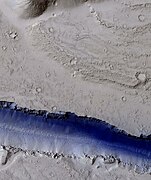











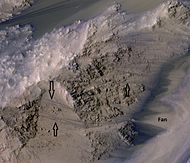














































































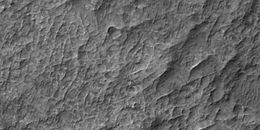


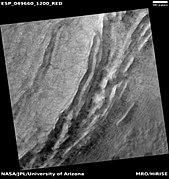


















![伊斯墨諾斯湖區]]各種大小坑底的環形模具隕石坑。](http://upload.wikimedia.org/wikipedia/commons/thumb/5/5a/ESP_037622_2200ringmoldfield.jpg/190px-ESP_037622_2200ringmoldfield.jpg)





![沿邊緣密佈着大量巨石的底座式撞擊坑被稱為「暈坑」[75]。](http://upload.wikimedia.org/wikipedia/commons/thumb/7/78/ESP_044939_2390pedestalhalocrater.jpg/190px-ESP_044939_2390pedestalhalocrater.jpg)





















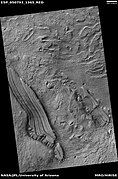







































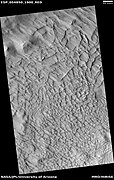


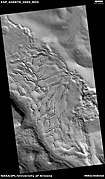













![出現在伊斯墨諾斯湖區的大量同心裂縫,裂縫是由冰下火山噴發形成的[110]。](http://upload.wikimedia.org/wikipedia/commons/thumb/9/93/25755concentriccracks.jpg/190px-25755concentriccracks.jpg)


































